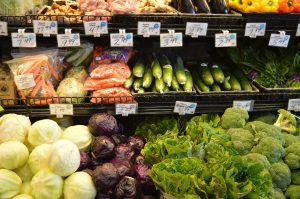 Sales of organic food have grown considerably since 1990 when the Organic Food Production Act was signed into law. That law authorized the U.S. Department of Agriculture’s National Organic Program. One of the many responsibilities of this program is to develop standards for organically-produced agricultural products that have the USDA organic seal, ensuring that products meet consistent, uniform standards. These standards, along with the USDA organic seal, were first implemented in 2002. The program also maintains a list of certified organic operations and helps farmers and businesses learn how to get certified. In 2017 there were more than 24,000 certified organic operations in the United States. Between 1990 and 2002 sales of organic food products increased nearly 9-fold, from $1 billion in 1990 to $8.6 billion in 2002. In 2017, sales were more than $45 billion.
Sales of organic food have grown considerably since 1990 when the Organic Food Production Act was signed into law. That law authorized the U.S. Department of Agriculture’s National Organic Program. One of the many responsibilities of this program is to develop standards for organically-produced agricultural products that have the USDA organic seal, ensuring that products meet consistent, uniform standards. These standards, along with the USDA organic seal, were first implemented in 2002. The program also maintains a list of certified organic operations and helps farmers and businesses learn how to get certified. In 2017 there were more than 24,000 certified organic operations in the United States. Between 1990 and 2002 sales of organic food products increased nearly 9-fold, from $1 billion in 1990 to $8.6 billion in 2002. In 2017, sales were more than $45 billion.
While still a small portion of overall food sales, organic food sales growth has outpaced overall food sales growth in each of the last ten years. Sales of organic food grew 17.5% in 2008, the highest growth in the last decade. That same year overall food sales grew 4.9%. In 2008, organic food sales made up 3.1% of all food sales in the country. By 2017, organic food sales grew to 5.5% of total food sales. Growth in the organic food sector that year slowed to 6.4%, but it was still well above the 1.1% growth in the overall food sector.
Fruits and vegetables were the largest organic food category in 2017, with sales of $16.5 billion, followed by dairy and eggs. However, the dairy and egg sector faced competition from the growing popularity of non-dairy milk alternatives and the USDA’s withdrawing of regulations in the Organic Livestock and Poultry Practices rule in 2017, which caused many consumers to question the meaning of the USDA seal on these products, reduced demand. Growth in organic beverage sales outpaced overall organic food sales growth by 64% in 2017. Sales of organic fresh juices alone jumped 25%, reaching $1.2 billion or slightly more than one-fifth of total organic beverage sales that year.
Today’s market size shows the total sales of organic food for the years 2008 and 2017. According to a study conducted by Nielsen, 82% of households in the lower 48 states regularly bought organic food in 2017. This is up considerably from just 3 years earlier when a Gallup poll reported that 45% of households actively try to include organic foods in their diet.
Geographic reference: United States
Year: 2008 and 2017
Market size: $20.4 billion and $45.2 billion respectively.
Sources: Maggie McNeil, “Maturing U.S. Organic Sector Sees Steady Growth of 6.4 Percent in 2017,” Organic Trade Association Press Release, May 18, 2018 available online here; “National Organic Program,” United States Department of Agriculture, Agriculture Marketing Service avalable online here; Nate Birt, “Study: 82% of U.S. Households Buy Organic Food Regularly,” AgWEb, March 24, 2017 available online here; Rebecca Riffkin, “Forty-Five Percent of Americans Seek Out Organic Foods,” Gallup, August 7, 2014 available online here; Laura Batcha, “Organic Farming Has So Many Benefits for People,” Lansing State Journal, July 22, 2018, page 9A.
Image source: ErikaWittlieb, “vegetables-supermarket-market-food-1100198,” Pixabay, December 22, 2015 available online here. Use of image does not constitute endorsement of supermarket shown.
